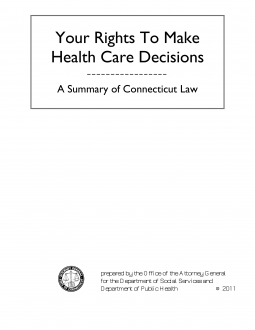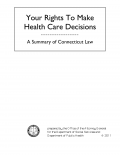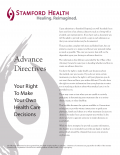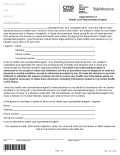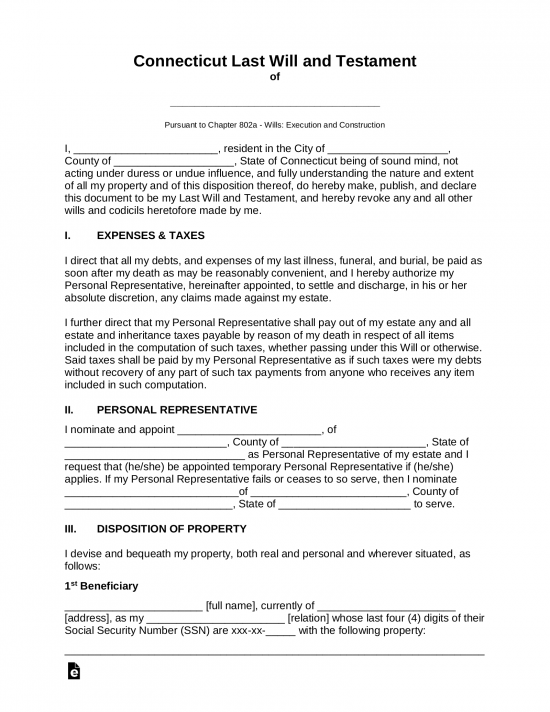Updated July 27, 2023
A Connecticut advance directive is a document that allows a person to create and legally identify a health care agent and end-of-life termination plan and is used in case the person cannot speak for himself or herself. This designates a person, usually a spouse or family member, to make medical decisions in the best interest of the patient. It also allows a person to deny a ventilator or the assistance of food and hydration if they should be permanently unconscious.
Advance Directive Includes
Table of Contents |
Laws
Statute – Removal of Life Support Systems[1]
Signing Requirements – Two witnesses.[2]
State Definition – “Advance health care directive” or “advance directive” means a writing executed in accordance with the provisions of this chapter, including, but not limited to, a living will, or an appointment of health care representative, or both.[3]
Versions (3)
Download: PDF
Download: PDF
Download: PDF
How to Write
Download: PDF
Directive Title
(1) Principal Or Declarant Name. The full name of the Connecticut Principal should be used to complete the title of the appointment form provided in this package. The Connecticut Principal is the future Patient who will be represented by a specific Party when a medical event renders him or her unable to communicate with Medical Professionals in the State of Connecticut.

(2) Status Of Appointment. This package begins with an appointment form that may be completed and issued at the discretion of the Connecticut Principal or Declarant. If this potential Patient does not wish to appoint a Health Care Representative, this directive may be issued as a living will. However, the Connecticut Principal or Declarant must verify the intent to refrain from appointing a Health Care Agent by initialing the appropriate statement.

Appointment Of Connecticut Health Care Agent
(3) Connecticut Health Care Representative. In order for a Connecticut Health Care Representative to possess the principal power to communicate with Physicians in this state on behalf of the Connecticut Principal or Patient, he or she will need to be assigned to this role by name. This Representative’s name will also need to be reproduced in the third paragraph. Make sure that both spellings of the Connecticut Health Care Representative’s name are identical.
(4) Alternate Connecticut Representative. An additional Party can be named in this document to be held as a Reserve Agent who does not possess any authority over the Principal’s directives unless the Connecticut Health Care Representative named above becomes unreachable, disqualified, unable, or unwilling to act on behalf of the Principal or potential Patient behind this document. This precaution can save valuable time since it enables the Principal to have the representation of his or her medical directives remain accessible to Connecticut Physicians even if his or her first choice of Health Care Agent does not fill this role at a time when he or she is incapacitated

Living Will Status
(5) Statement Of Intention. The next part of this document allows direct medical instructions to be established by the potential Patient or the Connecticut Declarant behind this issue. If the Connecticut Declarant will only issue the first part of this directive but refrain from setting his or her directives in a living will then, he or she must initial the statement verifying this omission.

Living Will Or Health Care Instructions
(6) Connecticut Declarant. The full name of the Connecticut Declarant or Principal must be presented to attach these directives to the correct Patient

Specific Instructions
(7) Accept Or Refuse Treatment Responses. The Connecticut Declarant’s instructions to Medical Professionals providing treatment when he or she cannot respond to questions or communicate will be issued through this part of the document. This process begins with a few basic treatment discussions often required to treat a serious medical event. By initialing either the “Provide” column or “Withhold” column the Connecticut Declarant can inform Medical Professionals in this state whether or not he or she will consent to the use of cardiopulmonary resuscitation, artificial respiration (i.e., a breathing machine), or artificially delivered nutrients and fluids.

(8) Other Specific Requests. The Connecticut Declarant can put his or her directions regarding medical treatment, facility expectations, and near-death preferences to paper directly in this document. It should be mentioned that any medical instruction not included in this section will not be considered as one delivered by the Declarant unless he or she has named a Representative with this knowledge. Thus, if more room is needed, insert additional lines, or continue on an attachment that is present from the time of this document’s signing until it is revoked.

Document Of Anatomical Gift
(9) Organ Donation Directive. If the Connecticut Declarant has decided not to be an Organ Donor, then his or her initials must be used to verify this stance. However, if the Connecticut Declarant intends to make anatomical gifts after death, then his or her initials will be the instrument to provide approval. The Connecticut Declarant should initial the appropriate statement to establish whether or not an anatomical gift or organ donation is authorized.

(10) Anatomical Gifts Preference. The Connecticut Declarant should choose one of the two statements displayed to indicate if the anatomical gift made should consist of any needed body parts or organs or if he or she will list specific body parts and organs authorized for donation in the space provided.
(11) Authorized Purpose Of Anatomical Gifts. In addition to defining the approved body parts and organs for a donation, the Connecticut Principal must check or mark Statement 1 to approve an anatomical gift to be made for any legal purpose or select Statement 2 to indicate that only the purpose(s) you define in this area will carry your authorization.

Designation Of A Conservator Of The Person
Select Either Item 12 Or Item 13
(12) Agent Nomination. Since this document is the second part of a package, it can be used to present the Connecticut Principal or Declarant’s desires regarding the potential appointment of a Conservator by Connecticut Courts. If the Principal does not wish to nominate a Conservator, then his or her initials will be required to waive this decision.
(13) Nominating A Conservator. If desired, the Connecticut Principal or Declarant can nominate a specific Party as his or her Conservator as well as name a second choice to assume this role for the consideration of a Connecticut State Court that has determined such an appointment is needed.
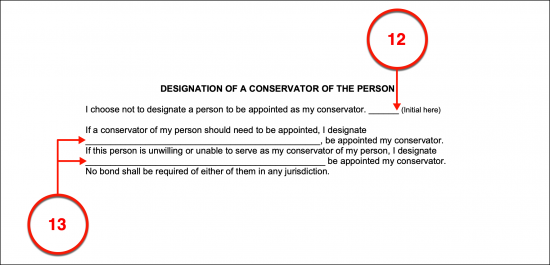
Signature Statement
(14) Connecticut Principal Or Declarant Execution. The signature of the Connecticut Principal (Declarant) is the only instrument that can execute this directive. This must be supplied before two Witnesses.
(15) Connecticut Principal Signature Date.

Witnesses’ Statements
(16) Statement Preparation. Since this directive must be executed by the Connecticut Principal or Declarant before two Witnesses, a Witness Statement has been provided. This area requires some preparation. Produce the Connecticut Principal’s name to complete the statement.
(17) Witness Confirmations. In order to verify that the directive was signed by the Connecticut Principal (or Declarant), each Witness who has observed the Principal’s signing should review the statement, then sign his or her name.
(18) Witness Addresses.
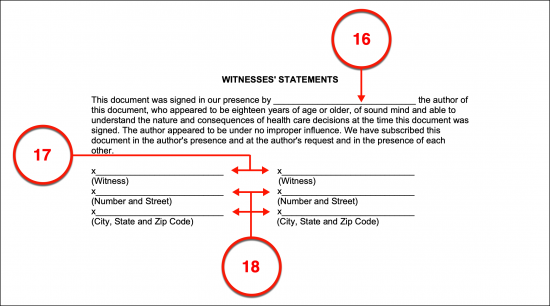
Witnesses’ Affidavits
(19) Notary Participation. A Notary Public will be needed to complete the Witnesses’ Affidavits area. This Party will verify the signature approval to a declaration regarding the signature each has observed. Once the Notary Public’s instructions have been followed, he or she will demonstrate the notarization process through the completion of this area.

Appointment Of Health Care Representative
(20) Connecticut Health Care Representative Identity. If the Connecticut Principal prefers, he or she can issue an appointment of a Health Care Representative separately without any connection to a living will. The third form in this package will allow this intention to be carried out. The first task will be recording the full name of the intended Health Care Representative the Principal wishes to work with Connecticut Health Care Professionals to decide upon treatment options for the Principal.

(21) Setting Up A Reserve Agent. The next declaration made in this document also seeks the Connecticut Health Care Agent’s full name. This will solidify that he or she is the primary choice for this role.
(22) Alternate Health Care Representative Identity. There is a possibility that the Connecticut Health Care Representative will be unable to carry out the role of the Connecticut Health Care Representative effectively leaving the Principal without appropriate medical representation. This can have drastic effects on the Principal’s treatment but can be avoided by declaring the identity of the Alternate Health Care Representative who will be granted authority (originally) given to the Primary Agent, if, and only if, the Primary Choice for Health Care Representative is ineffective (i.e., revoked, unwilling to act, or unavailable) and vacates this position. Declare the identity of the Alternate Health Care Representative for the Connecticut Principal.

Dated Execution
(23) Connecticut Principal Signing. The calendar date when the Principal delivers his or her signature must be reported on that day at the time of signing. Once the Connecticut Principal has established this date, he or she must sign this appointment to put it in effect. This act must be verified by two Witnesses willing to testify to the signature’s authenticity.Witnesses’ Statements.

(24) Connecticut Principal Identity. Prepare the Witnesses’ Statement with the full name of the Connecticut Principal who has signed this document.
(25) Witness Testimony. Each Witness to the Principal’s signing will be expected to agree to the testimonial provided with his or her signature and a record of the address where the Signature Witness resides.
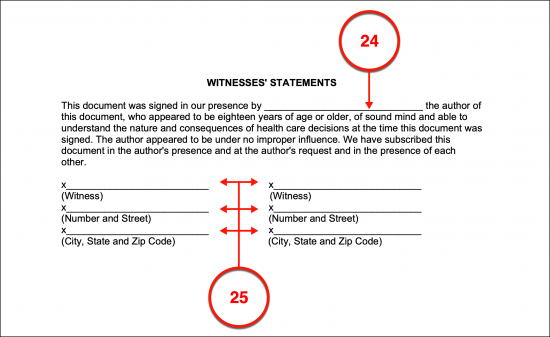
Witnesses’ Affidavits
(26) Notary Public Required. A Notary Public whose license is recognized by the State of Connecticut should be present for the Witnesses’ affidavit. This Party shall report on several points concerning the Connecticut Principal’s signing then require some participation from the concerned Witnesses. Once the notarization process is complete and the affidavit is ready, the Notary Public will complete the process then relinquish the affidavit to the Witnesses and Principal.

Connecticut Living Will
(27) Living Will Declarant. The Connecticut Principal may also execute his or her medical instructions directly to paper as a standalone document by completing the included living will. Before presenting such instructions, the Connecticut Principal must be identified by name as the Author of the concerned living will.

Treatment Decisions
Complete Items 28, 29, And 30
(28) Cardiopulmonary Resuscitation. The Connecticut Principal can provide direction to attending Doctors and First Responders regarding some standard responses to a life-threatening medical event using the brief table on display. The scenario where the Principal is found with a nonfunctional heart and set of lungs can pose an immediate danger of death. If the Principal intends to allow cardiopulmonary resuscitation administered in an effort to revive him or her, then the “Provide” column should be initialed. Otherwise, to deny this treatment the Connecticut Principal should initial the “Withhold” column.
(29) Artificial Respiration. If the Connecticut Principal is unable to breathe thereby preventing the oxygen needed to keep him or her alive and healthy, then Physicians will seek to aid this Patient with an artificial respirator or breathing machine. Sometimes this may involve a mask or the insertion of a tube. To give Connecticut Medical Professionals consent to use an artificial respirator for treatment the Principal must provide his or her initials. Similarly, only the Connecticut Principal’s initials can request that Connecticut Medical Staff withhold the use of a breathing machine or artificial respirator
(30) Artificial Means of Providing Nutrition And Hydration. The Connecticut Principal also has the opportunity to preapprove the artificial delivery of food and water when he or she cannot gain nutrients by eating or drinking and/or does not have the ability to physically perform these actions. Issue a directive on receiving artificially delivered nutrients and liquid that will either request Connecticut Physicians provide food and water (even if artificially) at all times or to inform Connecticut Health Care Professionals that the Principal refuses to be fed through a tube or a machine by initialing the appropriate column.
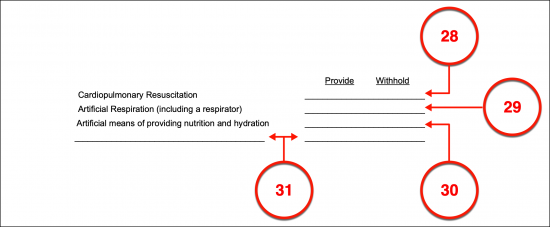
(32) Specific Requests. The directives can include a host of other topics the Connecticut Principal may wish documented. For instance, the Connecticut Principal may not wish to receive certain medications or may wish to approve of certain medications only under certain conditions. Topics such as the Connecticut Principal’s preferred Medical Facilities and which medical conditions he or she currently suffers from can also be engaged. The Connecticut Principal is encouraged to be as comprehensive as possible when discussing his or her treatment preferences. Once done, they should be presented where requested or named by title and attached.

Dated Signature
(33) Signature Date.
(34) Connecticut Declarant’s Signature. The Connecticut Principal must sign this document before two Witnesses.

Witnesses’ Statements
(35) Witness Statement Preparation. Provide the full name of the Connecticut Principal who has signed the living will before two Witnesses to the statement provided.
(36) Witness Signature And Address. Both Witnesses must sign their names and document their addresses to prove that they watched the Connecticut Principal sign the living will then relinquish this document to the Notary Public obtained for the required affidavit.
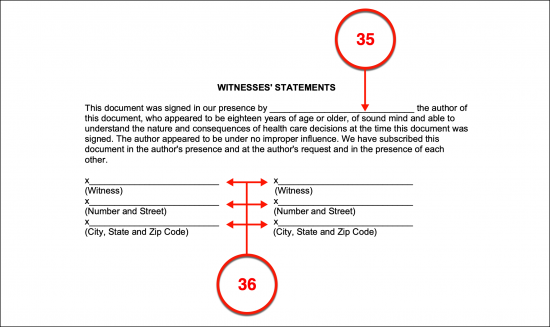
Witnesses’ Affidavits
(37) Notary Public Action. The Notary Public will deliver additional instructions to each Witness as part of the notarization process. Once he or she has completed and notarized the affidavit, the Notary Public will return the notarized document to the Witnesses and Connecticut Principal. The Principal is not required for the affidavit process however, it is recommended that an affidavit is completed at the time of the Principal’s signing if possible.
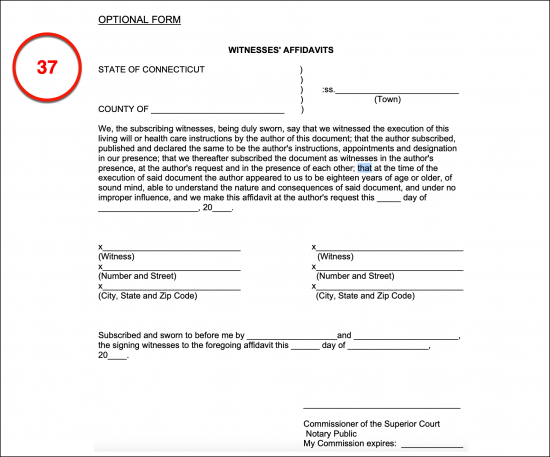
Related Forms
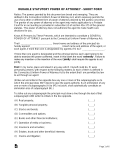 Durable (Financial) Power of Attorney
Durable (Financial) Power of Attorney
Download: PDF, MS Word, OpenDocument
Download: PDF, MS Word, OpenDocument

